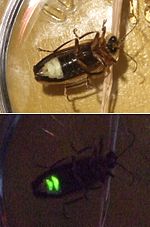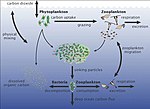Noctiluca scintillans is a marine species of dinoflagellate that can exist in a green or red form, depending on the pigmentation in its vacuoles. It can...
30 KB (3,598 words) - 02:47, 29 September 2024
by the bacterium Vibrio harveyi. Mareel is typically caused by Noctiluca scintillans (popularly known as "sea sparkle"), a dinoflagellate that glows...
10 KB (995 words) - 01:34, 24 April 2023
"Amoeba proteus | Microworld". www.arcella.nl. Retrieved 2016-08-21. "Noctiluca scintillans". University of Tasmania, Australia. 2011-11-30. Retrieved 2018-03-23...
52 KB (5,204 words) - 17:04, 22 September 2024
hanedai and Shewanella woodyi) Protists Certain Dinoflagellates (e.g. Noctiluca scintillans, Pyrodinium bahamense, Pyrocystis fusiformis and Lingulodinium polyedra...
11 KB (798 words) - 20:35, 2 July 2024
Symbiodinium sp. (Dinophyceae): zooxanthella, a coral endosymbiont Noctiluca scintillans (Noctiluciphyceae) Ciguatera Paralytic shellfish poisoning Yessotoxin...
96 KB (10,335 words) - 11:32, 9 September 2024
[Leptospathium Cachon & Cachon-Enjumet 1964] The most common species is Noctiluca scintillans, also called N. miliaris. Blooms of this species are red-orange...
6 KB (520 words) - 02:17, 8 March 2024
heliozoa, termed sun animalcules. Amoeba, termed Proteus animalcules. Noctiluca scintillans, commonly termed the sea sparkles. Paramecium, termed slipper animalcules...
4 KB (353 words) - 23:05, 13 August 2024
Noctiluca scintillans Metazooplankton with algal endosymbionts Most mixotrophic Rhizaria (Acantharea, Polycystinea, and Foraminifera) Green Noctiluca...
77 KB (7,077 words) - 07:14, 27 September 2024
Karenia brevis produces red tides highly toxic to humans Red tide Noctiluca scintillans, a bioluminescent dinoflagellate Sediments at the bottom of the...
232 KB (21,388 words) - 09:31, 2 June 2024
2012). "Use of a Noctiluca-killing bacterium Marinobacter salsuginis strain BS2 to reduce shrimp mortality caused by Noctiluca scintillans". Fisheries Science...
3 KB (282 words) - 15:26, 22 April 2024









